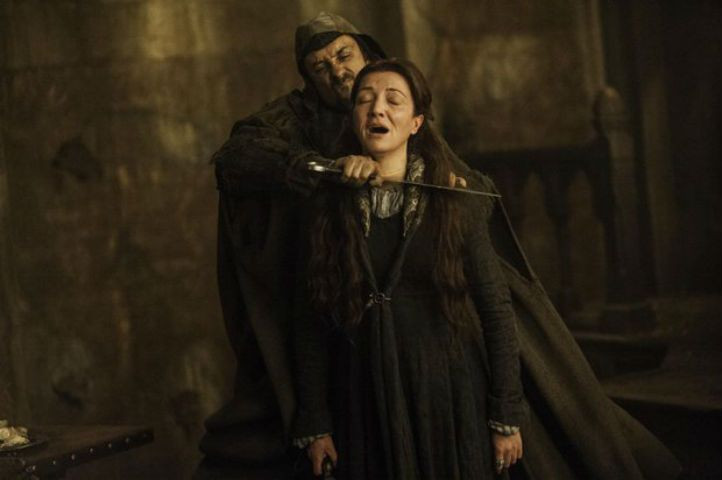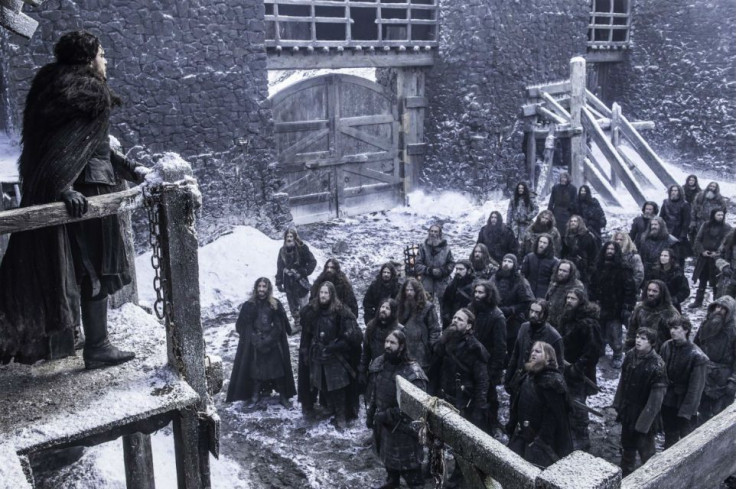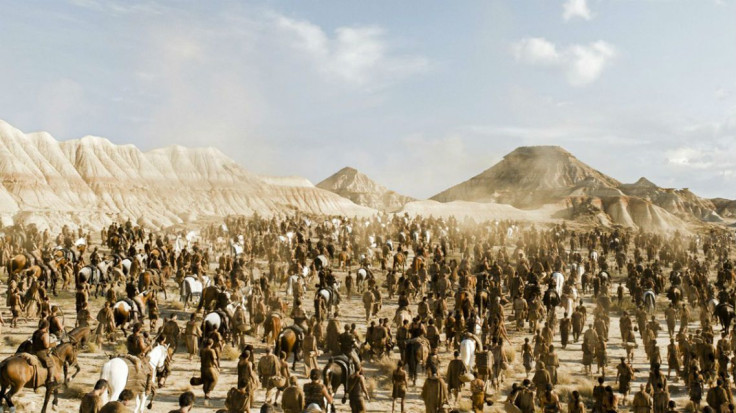Was ‘Game Of Thrones’ Really Inspired By These 4 Real People And Events?
The newest season of “Game of Thrones” is rapidly approaching and fans can hardly wait to see how the events of Season 7 will unfold. What may be even more fascinating for some fans as the new season arrives is trying to figure out if what they witness onscreen will actually be based off of a real event in history.
George R.R. Martin, who initially created the complex world of Westeros and the characters in it for his “A Song of Ice and Fire” book series, has previously opened up in the past about using true events and people from history as a source of inspiration when it comes to the situations the Starks, Lannisters, Baratheons, Targaryens and others find themselves in when it comes to both the books and the wildly popular TV show.
Read: What We Know About Season 7 Of “Game Of Thrones” From Episode Descriptions
Back in 2015, Martin revealed that the infamous Stark clan catchphrase on the show, “Winter is Coming,” was actually inspired by something which happened in his own life, when he was a college student in Chicago during the Blizzard of 1967.
“The coldest winter was in Chicago, let me tell you about cold. There was so much snow that winter, you couldn’t see, all snow, all ice, and it was so very cold,” he said at the time. “It was like the trenches during World War I, but they were trenches of ice. I remember walking through the trenches and the tunnels of ice, the wind blowing so you couldn’t even see. It’s an experience that never left me.”
Of course, not every famous event from the show was inspired by his own life, though several events and characters do have some roots in history. Here are 4 key parts of the show inspired by moments and people from history:
The Red Wedding:

As disturbing as the Red Wedding, which saw the brutal murders of Robb Stark (Richard Madden), Talisa Stark (Oona Chaplin), Catelyn Stark (Michelle Fairley), Robb and Talisa’s unborn baby and pretty much every man fighting for their army was, the fact that Martin based the massacre off of a real event is even more so.
In an interview with Entertainment Weekly in 2013, Martin explained how the general rule that the Starks would be warmly welcomed into the Frey household was based on real Hospitality laws that existed in the Dark Ages, and revealed that two different events—the Black Dinner of 1440 and the Glencoe Massacre of 1691 both heavily influenced what happened at the Red Wedding.
“The Red Wedding is based on a couple of real events from Scottish history. One was a case called The Black Dinner. The king of Scotland was fighting the Black Douglas clan. He reached out to make peace,” Martin explained. “He offered the young Earl of Douglas safe passage. He came to Edinburgh Castle and had a great feast. Then at the end of the feast, [the king’s men] started pounding on a single drum. They brought out a covered plate and put it in front of the Earl and revealed it was the head of a black boar—the symbol of death. And as soon as he saw it, he knew what it meant. They dragged them out and put them to death in the courtyard.”
“The larger instance was the Glencoe Massacre. Clan MacDonald stayed with the Campbell clan overnight and the laws of hospitality supposedly applied. But the Campbells arose and started butchering every MacDonald they could get their hands on. No matter how much I make up, there’s stuff in history that’s just as bad, or worse,” he added.
Read: Has Nikolaj Coster-Waldau Revealed That Cersei Will Die On Season 7 Of “Game Of Thrones?”
The Lannisters vs. The Starks:

The battle that continues to wage on between what’s left of House Stark of Winterfell and House Lannister of Casterly Rock/King’s Landing has been at the very core of the show since the very first episode, after Bran (Isaac Hampstead-Wright) was pushed through a window after he caught Jaime (Nikolas-Coster-Waldau) and Cersei (Lena Headey) having sex. Tension between the families intensified after Joffrey (Jack Gleeson) ordered Ned Stark’s (Sean Bean) beheading, Tywin (Charles Dance) backed the Red Wedding executions, and Sansa (Sophie Turner) was named as having worked with Tyrion (Peter Dinklage) to murder Joffrey. While other forces also played a role in the various goings on between the families as well—most notably master manipulator Petyr Baelish (Aidan Gillen)—the core conflict between the two families accounts for most of the drama that takes places in Westeros.
This conflict is based on the historical War of the Roses, a series of battles between the Lancasters and the Yorks for control of the English Throne. Martin himself confirmed that these particular battles have one of the most enormous impacts on his characters and their own stories.
“British history has played an enormous impact on ‘Game of Thrones’ and ‘A Song of Ice and Fire,” he told the UK’s Channel 4 News. “The Wars of the Roses are probably the single biggest influence. I’ve drawn from French history, and Scottish history, and other things, but at the center of it all is the Wars of the Roses. I have the Lannisters and the Starks, and in real life it was the Lancasters and the Yorks.”
The Wall:

The fictional behemoth of ice at the end of the world as those in Westeros know it is a fascinating place on the show. A brotherhood guards it, and by default, the rest of the realm, from any threats on the other side, namely Wildlings and White Walkers. The men at this Wall are a mix of volunteers, those who were disowned by their families, orphans, and criminals who had their sins pardoned by swearing to serve in the Night’s Watch. Though the men there are sworn not to participate in the politics that consume the rest of Westeros, their own political dramas still grip them.
While such a specific wall with these specific men was made up by Martin, the basis for a wall that is meant to keep out those who are unwanted is something from real life. Martin has previously revealed that his Wall is partially inspired by Hadrian’s Wall, a still partially standing landmark in the UK that was constructed during the Roman empire to keep the Romans safe from “barbarians.” Like the wall in “Game of Thrones” it also had multiple forts (castles in the fictional version) where guards kept watch.
The Dothraki:

The action in Westeros isn’t all that happens on “Game of Thrones.” Though Daenerys (Emilia Clarke) is now headed to her ancestral homeland to take back the Iron Throne, she has spent the last six seasons entirely in Essos, at Vaes Dothrak, Qarth, and Slaver’s Bay, where she liberated the slaves in Astapor, Yunkai and Meereen. A huge part of her story however comes from the Dothraki tribes she started her story with, and her marriage to Khal Drogo (Jason Momoa). The Dothraki tribes are many, and they are known for essentially conquering, pillaging and raping as they ride on horseback throughout their continent. They are fierce warriors, and great allies for Daenerys to have on her side, even though they’ve never before crossed the Narrow Sea.
These tribes aren’t a figment of George R.R. Martin’s imagination however. In fact, he has previously admitted that his Dothraki characters and tribes are partially based off of the Mongols and the Huns, and Genghis Khan may have been an inspiration for Drogo as well.
“The Dothraki are partially based on the Huns and the Mongols, some extent the steppe tribes like the Alvars and Magyars. I put in a few elements of the Amerindian plains tribes and those peoples, and then I threw in some purely fantasy elements. It’s fantasy,” he told Gizmodo in 2013. “Are they barbaric? Yeah, but the Mongols were, too. Genghis Khan... I’ve read books about Genghis Khan, and he’s one of history’s more fascinating, charismatic characters. The Mongols became very sophisticated at certain points, but they were certainly not sophisticated when they started out, and even at the height of their sophistication they were fond of doing things like giant piles of heads. ‘Surrender your city to me, or we will come in and kill all the men, rape all the women and make a giant pile of heads.’”
“Game of Thrones” season 7 premieres July 16 at 9 p.m. on HBO.
© Copyright IBTimes 2024. All rights reserved.





















